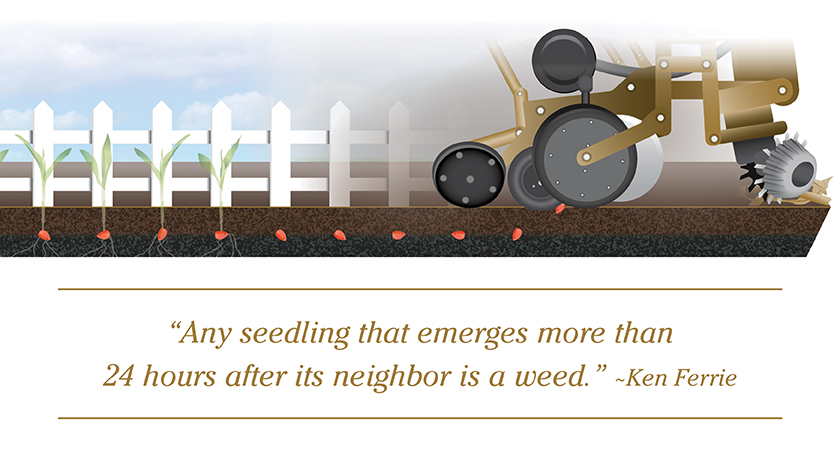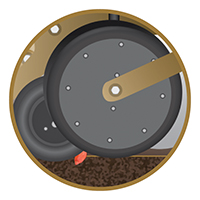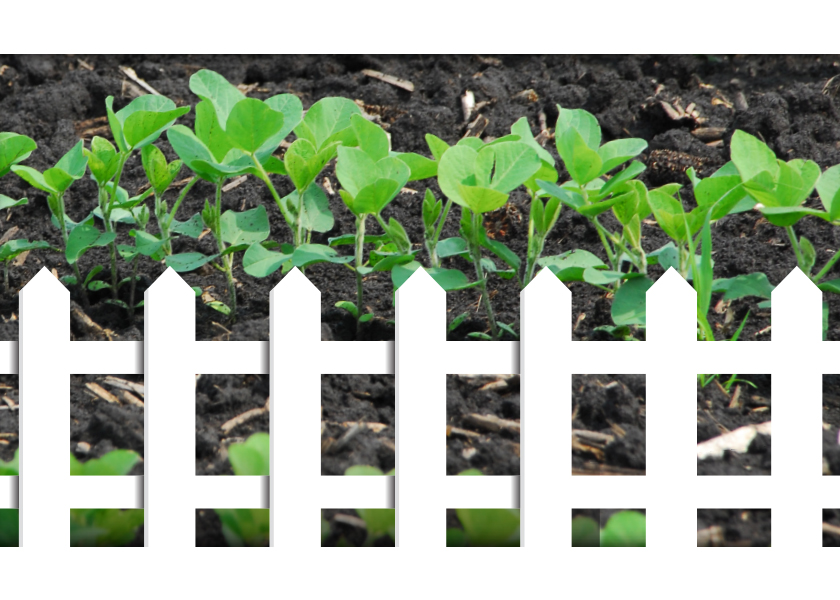Do Pretty Corn Fields Actually Translate Into Higher Yields?

Modern, high-tech planters can produce “picket fence” stands of corn with seedlings so uniform they look like they’ve been photocopied. While pretty fields are without a doubt a source of pride, do pretty fields actually translate into higher yields?
Experts say yes but admit it’s a challenge to correlate planter performance with final yields.
“Corn can compensate to some degree for variations in seed spacing and emergence,” says Kevin Juhl, John Deere marketing manager. “But no hybrid can compensate 100% for metering and seed placement problems that create skips, doubles or uneven emergence. Precise metering and seed placement give a corn crop the best chance to achieve highest yield.”
EMERGENCE TIMING
While precise seed spacing produces pretty fields, timely emergence of seedlings is a big impact on yields.
“We want ‘photocopy plants,’ plants that look identical, that emerge evenly and stay uniform through V4 and V6 when ear size is being decided,” says Dave Brennan, Case IH planter marketing manager. “If we can get a picket fence stand from high metering accuracy, and photocopy plants from consistent depth control that gives uniform emergence, that’s when we see significant yield benefits from a high-tech planting system.”
Jason Webster, commercial agronomist with Precision Planting’s Precision Technology Institute, says his “All Wrong Study” shows the benefits of accurate seed metering and automatic down-pressure systems.

“We created a planter that would plant, ‘all wrong,’” Webster says. “We took a vDrive system and mechanically altered it to plant at only 95% singulation. Then we adjusted the hydraulic downforce system to simulate the way T-handle, spring-controlled downforce systems work, with one, static downforce setting. We compared that planter to a planter that had a vDrive system that singulated at 99%, with an automated hydraulic downforce system that could automatically adjust to maintain uniform downforce across the field.”
Last year, Webster says, the difference between the “all wrong” planter and the planter that could do the best job possible with plant spacing and uniform emergence was 16.6 bu. per acre.
“With corn at $5, that was an $83 per acre difference,” he says. “That shows how sensitive corn yields can be to the potential that high-tech planters provide.”
Components Working in Concert

Seed meters control singulation. Singulation is a calculation, displayed on monitors in tractor cabs as a percentage, of the number of skips and/or doubles a seed meter discharges. “You’re leaving profit in the field if your singulation is less than 98%,” says Blake Bergkamp, Great Plains agronomist. “If you’re planting 35,000 seeds per acre, and there’s one skip every 17.4', it leads to a loss of 1,000 plants per acre and an average yield loss of 5 bu. to 7 bu. per acre.”
Automated row cleaners play a role in improved emergence. “Moving clods and creating a smooth path for the gauge wheels definitely influences  singulation,” says Clayton Stufflebeam, Becks Hybrids agronomist. “The less seed meters bounce, the better they singulate. Row cleaners also help keep crop residue out of the seed furrow. Last year, when digging skips and late emerging seedlings, I often found residue beside the seed that had created an air pocket or sucked moisture away from the seed. Time spent adjusting row cleaners to provide a smoother ride produces better singulation from the meter and reduces furrow contamination that can delay emergence.”
singulation,” says Clayton Stufflebeam, Becks Hybrids agronomist. “The less seed meters bounce, the better they singulate. Row cleaners also help keep crop residue out of the seed furrow. Last year, when digging skips and late emerging seedlings, I often found residue beside the seed that had created an air pocket or sucked moisture away from the seed. Time spent adjusting row cleaners to provide a smoother ride produces better singulation from the meter and reduces furrow contamination that can delay emergence.”

Automated hydraulic downforce systems have the biggest effect on yield of any high-tech planter component. “Variations in seed depth are a leading cause of variations in emergence,” says Cory Muhlbauer, Precision Planting research and development agronomist. “Automatic downforce systems maintain consistent seed depth.”
Farm Journal Field Agronomist Ken Ferrie has famously stated, “Any seedling that emerges more than 24 hours after its neighbor is a weed.” Precision Planting studies that tracked the size and number of ears from seedlings that emerged more than 24 hours after other seeds showed a 6% yield reduction compared to their neighbors.
Hydraulically-actuated downforce systems can increase or decrease downforce, adds Case IH’s Brennan. “Being able to sense and automatically reduce downforce as soil conditions change across a field is just as important as being able to increase it,” he says.
Planting Speeds
Planting speeds available with high-speed planters influence final yields in three ways: singulation, emergence and planting window.
Speeds above 6 mph, especially in combination with rough seedbeds, can decrease singulation and spacing accuracy because of row unit vibration and bounce.
- Ground speed also influences seed depth, hence emergence.
“As ground speed increases, you have to increase downforce to keep the disk openers at the desired depth,” says John Deere’s Juhl. “You also have to make down-pressure adjustments more quickly, and that’s the advantage of automated individual hydraulic downforce systems that can react almost instantaneously on a row-byrow basis as soils change from one part of a field to another.”
- Higher ground speeds also mean fewer days in the field.
“There’s a penalty for not getting all your planting done in a timely fashion,” Juhl says. “Research shows if you go outside the optimum planting window for your area and plant too late, it can lead to a 3% to 5% yield decrease.”
A final consideration for planting speed is the increased horsepower required to pull planters faster.
“It varies with soils, topography and how the planter is accessorized, but if you’re planting at more than 6 mph, you’re going to need a Clydesdale,” says Case IH’s Brennan.
Soybeans: The Next Frontier For Precise Planting?

If precise seed metering and depth control benefits corn, does it also benefit soybeans and other crops?
“Iowa State University did a three-year study,” says Kevin Juhl with John Deere. “The soybean survivability rate for planters equipped with [John Deere] ExactEmerge and Individual Row Hydraulic Downforce [IRHD] systems was 7% higher than non-ExactEmerge planters without IRHD. It appears that soybean yields benefit from planting technologies that offer accurate seed metering and depth control.”
Download a “12 Steps to A Perfect Stand” eBook and a tip sheet for readying your planter this spring
Dan Anderson brings his vast knowledge of farm equipment, technology, machinery repair and field operations to Farm Journal readers with his regular column and blog on AgWeb.com.







